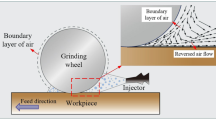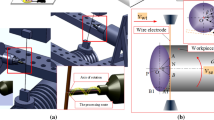Abstract
DD5 Ni-based single-crystal superalloy has presented a wide application prospect in aerospace, marine, nuclear reactor, and chemical industries due to its excellent comprehensive performances caused by the crystal boundary as the crack source complete elimination. However, because of the low thermal conductivity and strong adhesion characteristic, DD5 is difficult to machine and the research on this field is still blank. Therefore, the purpose of this paper is to investigate the material machining mechanism and optimize the milling performance. Based on the DD5 metallographic structure characteristics, the directional cutting method was proposed firstly. Then, considering the wear characteristic and failure mode of the tools with different coating materials, the milling tool proper selection was executed. Moreover, combining with the molecular dynamics (MD) simulation, slot milling experiments, and slip system theory, the best milling path was confirmed. In addition, considering the machining environmental sustainability, the milling performances acquired under the dry, minimal quantity lubrication (MQL) and water-based MQL conditions were evaluated and compared. Finally, in order to optimize the machining parameter sequence quantitatively and ascertain the milling and cooling interactive effect mechanism, response surface method (RSM), back-propagation artificial neural network (BP-ANN), genetic algorithm (GA), and uniform design experiments were all adopted. With the anticipation to improve environmental sustainability and milling performance simultaneously, the milling experiments on the DD5 (001) crystal plane along the [110] crystal direction under the water-based MQL technology with PVD-TiAlN-coated tools were conducted and the parameters of main spindle linear speed v c = 20 m/min, tool feed per tooth f = 8.97 μm, oil flow rate Q = 68.21 ml/h, the ratio of water and oil R = 0.94 and the air pressure P = 1.79 bar were used. Then, the better surface roughness Sa = 2.05 μm and the lower milling force F = 14.38 N can be acquired simultaneously based on the verification of the uniform design experiment results.
Similar content being viewed by others
References
Thakur A, Gangopadhyay S (2016) State-of-the-art in surface integrity in machining of nickel-based super alloys. Int J Mach Tool Manu 100:25–54
Durul U, Tugrul O (2011) Machining induced surface integrity in titanium and nickel alloys: a review. Int J Mach Tool Manu 51(3):250–280
Imran M, Mativenga PT, Gholinia A, Withers PJ (2014) Comparison of tool wear mechanisms and surface integrity for dry and wet micro-drilling of nickel-base superalloys. Int J Mach Tool Manu 76(1):49–60
Zhu D, Zhang X, Ding H (2013) Tool wear characteristics in machining of nickel-based superalloys. Int J Mach Tool Manu 64(1):60–77
Cui RJ, Huang ZH (2016) Microstructual evolution and stability of second generation single crystal nickel-based superalloy DD5. T Nonferr Metal Soc 26(8):2079–2085
Zhou J, Bushlya V, Avdovic P, Ståhl JE (2012) Study of surface quality in high speed turning of Inconel 718 with uncoated and coated CBN tools. Int J Adv Manuf Technol 58(1–4):141–152
Cantero JL, Díaz-Álvarez J, Miguélez MH, Marín NC (2013) Analysis of tool wear patterns in finishing turning of Inconel 718. Wear 297(1–2):885–894
Park KH, Yang GD, Dong YL (2015) Tool wear analysis on coated and uncoated carbide tools in inconel machining. J KSPE 16(7):1639–1645
Zhang S, Li JF, Wang YW (2012) Tool life and cutting forces in end milling Inconel 718 under dry and minimum quantity cooling lubrication cutting conditions. J Clean Prod 32(3):81–87
Umbrello D (2013) Investigation of surface integrity in dry machining of Inconel 718. Int J Adv Manuf Technol 69(9–12):2183–2190
Hao ZP, Fan YH, Lin JQ, Yu ZX (2015) Wear characteristics and wear control method of PVD-coated carbide tool in turning Inconel 718. Int J Adv Manuf Technol 78(5):1329–1336
Li Q, Gong YD, Cai M, Liu MJ (2017) Research on surface integrity in milling Inconel718 superalloy. Int J Adv Manuf Technol:1–15
Tan L, Yao C, Ren J, Zhang DH (2016) Effect of cutter path orientations on cutting forces, tool wear, and surface integrity when ball end milling TC17. Int J Adv Manuf Technol 88:2589–2602
Wu X, Li L, He N, Zhao M, Zhan ZB (2015) Investigation on the influence of material microstructure on cutting force and bur formation in the micro cutting of copper. Int J Adv Manuf Technol 79(1):1–7
Nakasuji T, Kedera S, Hara S (1990) Diamond turning of brittle materials for optical component. Ann CIRP 39(1):89–92
Kota N, Ozdoganlar OB (2012) Orthogonal machining of single-crystal and coarse-grained aluminum. J Manu Process 14(2):126–134
Zhou Y, Gong Y, Cai M et al (2017) Study on surface quality and subsurface recrystallization of nickel-based single-crystal superalloy in micro-grinding. Int J Adv Manuf Technol 90(5–8):1749–1768
Zhang J, Sun T, Yan Y, Liang YC, Dong S (2007) MD simulation of effect of crystal orientation and cutting direction on Nanometric cutting using AFM pin tool. Chin J Chem Phys 20(6):619–624
Zhu L, Peng SS, Yin CL, Jen TC, Cheng X, Yen YH (2014) Cutting temperature, tool wear, and tool life in heat-pipe-assisted end-milling operations. Int J Adv Manuf Technol 72(5):995–1007
Park KH, Suhaimi MA, Yang GD, Lee DY, Lee SW, Kwon P (2017) Milling of titanium alloy with cryogenic cooling and minimum quantity lubrication (MQL). Int J Precis Eng Man 18(1):5–14
Barczak LM, Batako ADL, Morgan MN (2010) A study of plane surface grinding under minimum quantity lubrication (MQL) conditions. Int J Mach Tool Manu 50(11):977–985
Pinar AM, Filiz S (2016) A comparison of cooling methods in the pocket milling of AA5083-H36 alloy via Taguchi method. Int J Precis Eng Man 83(9):1431–1440
Obikawa T, Asano Y, Kamata Y (2009) Computer fluid dynamics analysis for efficient spraying of oil mist in finish-turning of Inconel 718. Int J Mach Tool Manu 49(12–13):971–978
Bhowmick S, Lukitsch MJ, Alpas AT (2010) Dry and minimum quantity lubrication drilling of cast magnesium alloy (AM60). Int J Mach Tool Manu 50(5):444–457
Wang CD, Chen M, An QL, Wang M, Zhu YH (2014) Tool wear performance in face milling Inconel 182 using minimum quantity lubrication with different nozzle positions. Int J Precis Eng Man 15(3):557–565
Huang X, Ren Y, Jiang W, He ZJ, Deng JH (2017) Investigation on grind-hardening annealed AISI5140 steel with minimal quantity lubrication. Int J Adv Manuf Technol 89:1069–1077
Najiha MS, Rahman MM (2016) Experimental investigation of flank wear in end milling of aluminum alloy with water-based TiO2 nanofluid lubricant in minimum quantity lubrication technique. Int J Adv Manuf Technol 86(9–12):2527–2537
Lin H, Wang C, Yuan Y (2015) Tool wear in Ti-6Al-4V alloy turning under oils on water cooling comparing with cryogenic air mixed with minimal quantity lubrication. Int J Adv Manuf Technol 81(1):87–101
Kilickap E, Huseyinoglu M (2011) Optimization of drilling parameters on surface roughness in drilling of AISI 1045 using response surface methodology and genetic algorithm. Int J Adv Manuf Technol 52(1):79–88
Zhou YG, Gong YD, Zhu ZX, Gao Q, Wen XL (2016) Modelling and optimization of surface roughness from micro grinding of nickel-based single crystal superalloy using the response surface methodology and genetic algorithm. Int J Adv Manuf Technol 85(9):2607–2622
Mahesh G, Muthu S, Devadasan SR (2015) Prediction of surface roughness of end milling operation using genetic algorithm. J Mech Sci Technol 77(1):369–381
Azadi Moghaddam M, Kolahan F (2016) Application of orthogonal array technique and particle swarm optimization approach in surface roughness modification when face milling AISI1045 steel parts. J Ind Eng Int 12(2):199–209
Somashekhar KP, Mathew J, Ramachandran N (2012) A feasibility approach by simulated annealing on optimization of micro-wire electric discharge machining parameters. J Adv Manuf Technol 61(9):1209–1213
Emami M, Sadeghi MH, Sarhan AAD (2013) Investigating the effects of liquid atomization and delivery parameters of minimum quantity lubrication on the grinding process of Al2O3 engineering ceramics. J Manu Process 15(3):374–388
Aggarwal S, Xirouchakis P (2013) Selection of optimal cutting conditions for pocket milling using genetic algorithm. J Adv Manuf Technol 66(9–12):1943–1958
Huang Y, Zhang J, Li X, Tian L (2014) Thermal error modeling by integrating GA and BP algorithms for the high-speed spindle. J Adv Manuf Technol 71(9–12):1669–1675
Wang ZH, Gong DY, Li X et al (2017) Prediction of bending force in the hot strip rolling process using artificial neural network and genetic algorithm (ANN-GA). Int J Adv Manuf Technol (4):1–14.
Andre J, Siarry P, Dognon T (2001) An improvement of the standard genetic algorithm fighting premature convergence in continuous optimization. Adv Eng Softw 32(1):49–60
Hrstka O, Kučerová A (2004) Improvements of real coded genetic algorithms based on differential operators preventing premature convergence. Adv Eng Softw 35(3):237–246
Author information
Authors and Affiliations
Corresponding author
Rights and permissions
About this article
Cite this article
Li, Q., Gong, Yd., Sun, Y. et al. Milling performance optimization of DD5 Ni-based single-crystal superalloy. Int J Adv Manuf Technol 94, 2875–2894 (2018). https://doi.org/10.1007/s00170-017-0999-1
Received:
Accepted:
Published:
Issue Date:
DOI: https://doi.org/10.1007/s00170-017-0999-1




